Sábado De Gloria
Saturday, April 15, 2006
Holy Saturday is called sábado de gloria in Spanish. I have never known why this day, in which nothing really happens is called a Saturday of glory. It seems like today is a day of transition in which me meditate on a death without knowing for certain if a resurrection will follow.
When I asked Lauri Stallings to hover near composer Owen Underhill in 1997 in preparation for Ballet BC's production of Boy Wonder I felt great comfort and peace.
Quietly Communist
Friday, April 14, 2006
  My first job in Vancouver, 30 years ago, was at Tilden Rent-A-Car on Alberni Street, across from the Ritz Hotel (If you have to ask, you are too young). I was told not to rent cars to anybody surnamed John or George. I did not understand. Finally the manager said, "Don't rent to Indians." I decided to rent a car, no questions asked, to the first "Indian" that walked through the door. That Indian was a very large and rough looking man called Moving Rock. I rented him (he did not have a driver's license) an Oldsmobile station wagon. For reference Moving Rock gave me Alderman Harry Rankin. Most of us were in awe of Rankin. I called and Rankin told me I was not going to have any problems with Moving Rock. A month later the abandoned station wagon was found in Arizona. I was almost fired. Furthermore I was not to rent to any more rocks, Indians or a Johnny Stone. Stone, who was a good renter of mine, was a black pimp from Seattle. He rented modest Vegas and always returned them spotless and on time. In September 1987 Alderman Rankin was running for mayor against Gordon Campbell. Equity Magazine's editor, Harvey Southam thought Campbell the better man to keep the status quo so he hired right-wing columnist and writer Doug Collins to write a profile. I was dispatched with the instructions to use my green filter, b+w technique on Rankin. I told Rankin that the green filter was going to make him look older. His retort, "Go ahead shoot, I don't give a f...." When the magazine appeared in October I was amazed to see my two page spread with the huge banner, Quietly Communist on top.
Nitobe Memorial Garden at UBC
Thursday, April 13, 2006
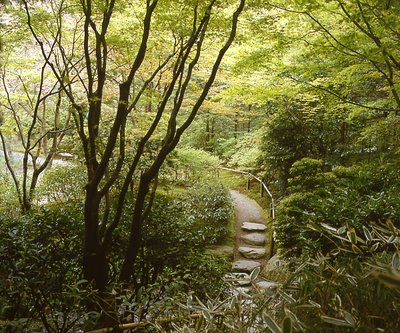 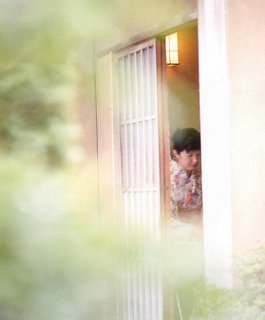 When I first came to Vancouver 30 years ago I had seen perhaps 10 real live Japanese people in my life. They had been my 10 students, from the Japanese company Mitsui, that I had taught Spanish to in Mexico City. I was fascinated by all things Japanese. Japanese is pronounced exactly like Spanish as they have only five vowel sounds. I could proudly read what was on the lenses of my cameras - Asahi Pentax - Nippon Kogaku (the original Nikon lenses had this). Sometimes you have to be a newcomer or a tourist to a city to discover its treasures. One of Vancouver's is the Nitobe Memorial Garden at UBC. It is part of the UBC Botanical Garden. But let's be exact. That's UBC Botanical Garden and Centre of Plant Research. A real botanical garden does reasearch and exchanges information with other botanical gardens worldwide. VanDusen, for example is display garden as it does not do research. Some years ago Saturday Night assigned me to photograph Nitobe Garden. The author of the piece was/is my friend David Morton. While I considered myself a competent portait photographer I was an innocent with gardens. It took me a while to figure out (only after I peeked at Japanese garden spreads in Japanese camera magazines) that Japanese gardens are best photographed on cloudy days. I learned then what I now try to teach my students at Focal Point. The big enemy of photography is contrast. I would define photography as the control of contrast. To get all those shades of green at Nitobe you need to wait (not long in Vancouver) for a cloudy day. You also try to use film with the least amount of contrast. This is usually professional colour slide film or good old wedding photography colour negative. Digital cameras have to have their contrast levels dialed down. And why is Nitobe Garden a treasure? The water and those greens are most soothing. The garden is also quiet. One of my favourite games is to pick one of the koy and to follow it around as it meanders in the pond. Nitobe
UBC Botanical Garden And The Russian Connection
Wednesday, April 12, 2006
 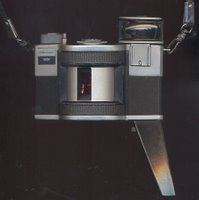 My Horizont swivel lens panoramic camera was made in the Soviet Union in the 60s. It is highly unpredictable and unreliable but it has a sharp lens. The lens swivels a 150 degree sweep which I think mimics human vision (albeit with a sharper peripheral view). When I load it with Kodak b+w infrared film the results are even more unreliable and unpredictable. But when things go well you get this. The curious split toning colour is caused by selenium toner working on the now (alas!) discontinued Agfa Portriga. On a sunny day the view (on the right) at the end of the boardwalk at the UBC Botanical Garden is one of the most beautiful sights I have ever seen. UBC Botanical Garden
Sex Crimes, Homicide and Drugs
Tuesday, April 11, 2006
 |
| Gil Pruder, left & Constable Steven Pranzl |
Manrique was a plainclothes cop. My father, who was a journalist for the Buenos Aires Herald, used to bring him to the house. I was so curious in trying to spy the gun he wore under his coat that I never found out if Manrique was his first or last name nor why he visited my father. In one visit Manrique gave me a cheap Thor copy of Edmundo de Amicis's Corazón which I have read many times and still have. I can say I have had a special interest in cops since. In Mexico I was afraid of cops and I bribed many while there. It has been a relief in my 30 years in Vancouver to have never felt that dread I had in Mexico when I was stopped by a cop.
One cop, in particular I came to like, lots. I photographed Constable Steven Pranzl (above, right) for the cover of Vancouver Magazine in June 1986. We all laughed at how our makeup artist overdid it and many in the Vancouver Police Department thought Pranzl looked like a queen. At the time he was in sex crimes. Through the years I have kept in touch with this stylish and urbane man. The last time I had some Earl Gray tea with him, he was wearing a camel hair coat from Holt Renfrew, an immaculate black turtle neck, beautiful slacks with a sharp crease and burgundy tassel shoes. "I am in homicide now," and producing a pepper spray can, "and this is my gun."
I met Gil Puder (above, left) in June 1999. We had coffee at the Ovaltine Cafe on West Hastings. I had been hired by Douglas & McIntyre to photograph him for his forthcoming personal expose on the drug situation in Vancouver as seen by a cop on the beat. The book was to be called Crossfire. We decided not to photograph him in a back alley but in my studio. For personal reasons (or reasons he was not willing to reveal to me) he could not pose in a Vancouver Police uniform. He confessed to me that he had an unusual mid life crisis problem. Or at least it was his wife's as she had left him and puchased a Miata at the same time. After taking the photographs, a couple of months later I had to photograph an actor in a back alley who was making a movie. I asked one of the motorcycle cops there if he knew Puder. His exact answer (to the effect that the sooner Puder was dead the better) I cannot print here. A few months later I read of his death in the Vancouver Sun. Perhaps I am a bit paranoid in having noticed that a writer at the publisher told me Puder had died of an ailment that was not the one mentioned in the Sun. Shortly after, I was paid for the photos and the book project was cancelled. The unofficial explanation that I was given was that with the author dead nobody was keen on taking the chance of dealing with a lawsuit by what may have been the explosive content of his book.
Addendum 1. - October 7, 2007
name: Christine Puder
comments: Hi Alex,
I was looking for a photographer and came across your information as
I searched. I am the widow of Gil Puder. I was somewhat dismayed
at the information posted about Gil on your site. Some of the
information is not true and is damaging for myself and my sons. I
would be glad to help it appear accurately if you choose to have it up
for everyone to see. It is personally upsetting as I did not leave Gil, nor buy a sportscar. His death was from melanoma and my sons and I spent all our time with Gil during his final days at the hospital.
Thank you for your consideration,
Sincerely,
Christine Puder
Addendum 2
I could have not heard correctly what Mr. Puder told me in my studio during the photo session. Or perhaps if I heard correctly, his disease prevented him from expressing himself correctly. I am deeply sorry that I may have offended unknowingly (when I wrote the above) her and her children. But I would never consider either tearing out or correcting a page from my diary. On the other hand Christine Puder was gracious enough not to point out that I had incorreclty spelled her husband's first and last name in my above blog. I have corrected that.
An Estonian, The Change Ringer & St Martin In The Fields
Monday, April 10, 2006
Some years ago while in London, I decided to go and see a Graham Greene play, Travels With My Aunt. At the intermission I was savouring the feeling of not running into anybody I knew or had photographed. That was not to be. The mysterious and handsome Laith Reynolds (I once asked him if he were a spy and he smiled without answering), stood in front of me producing a hand with a spotless white, cotton glove. "I have a skin, condition, you know." He offered to pick me up very early in the morning at my hotel to take me to listen to him change ring at St Martin in the Fields and at St Clement Danes. People go to St Clement Danes to see the statue of Sir Arthur "Bomber" Harris that is outside. That evening Laith drove me (he owns a Jaguar in every city that he lives in) to his house for a drink and to meet his wife. His house was on one of those famously circular streets with very expensive and old houses. Change ringing is an English art that has a worldwide following and whose members communicate in patterns that to me seem to be almost masonic. After listening to Laith (the man on the right with the white shirt and tie) and the other folks ring the bells in patterns that only the learned can discern, we walked down the spiral staircase of the bell tower. We finished the day looking at the Templar tombs in the Temple Church. My 50mm F-1.4 Nikon lens fell out of my bag and rolled all the way down before I could catch it. For the last ten years I have taken pictures with a cracked rear element. I regret to this day turning down (I said I didn't have the time) Laith's offer to take me to ring the bells at St Paul's Cathedral the next day.
Maanus Pikker, an Estonian engineer I met at Wreck Beach (fourth from the right), says I snapped this with his camera. After not seeing him for 27 years he contacted me and we had tea at the Granville Island Tea Company. He offered me the gift of a pristine Nikon FM (sort of like opening a barn door in the sticks and finding a brand new Wolkswagen Beetle). The camera came with a 50mm F-1.4 NIkon lens in mint condition.
Einstein And A Streetcar Named Desire
Sunday, April 09, 2006
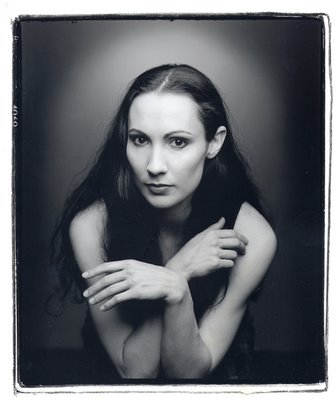
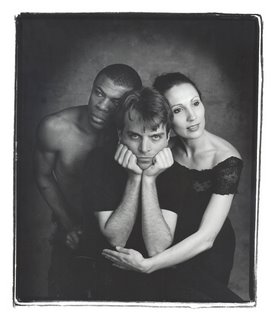
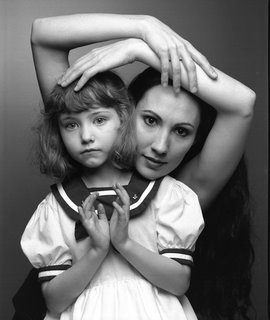
Taking my 8-year-old granddaughter Rebecca to the Saturday matinee performance of Ballet BC's A Streetcar Named Desire was a tough proposition. How do you explain the plot and sexual shenanigans? Luckily there were other things that kept her interest. Before the show I introduced her to percussionist Sal Ferreras, who in his perfect Puerto Rican Spanish, explained that you don't call a vibraphone a vibraharp. Tobin Stokes's score was a pleasure to listen to as was Bill Sample's piano. But for me the unifying symbol of the music was the recurring and beautifully reproduced sound of a passing streetcar complete with an Einsteinian change of pitch as the trolley recedes in distance. Sal Ferreras did this by striking a marine bell and then slowly dunking it into a bucket of water. The other unifying symbol was dancer Simone Orlando who plays Blanche DuBois with such class that you almost forget that she ends up at that house of ill repute, the Flamingo. For years I admired many of the female dancers of Ballet BC. I remember Crystal Pite's elegance, the classic Andrea Hodge, the one-of-a-kind Emily Molnar, the fragile redhead Lauri Stallings and recently, the erotic/passionate Sandrine Cassini. I just never really noticed Simone Orlando. Then on February 28, 2004 she came to my studio for photographs. Rebecca was there as my "assistant". We were both charmed but there was something more. I have not been able to take my eyes off Simone whenever she is on stage. A few months later, after a Ballet BC performance I sent Rebecca back stage. It seems that she was invited into Simone's changing room and she emerged with a used pair of Simone's pointe shoes. I believe that Rebecca must have slept with them that night. When we went to congratulate Simone after the performance, we found a barefoot Simone. Rebecca noticed. "Did you see Simone's feet, Papi?" As delicate as Simone is you can see how hard she works at it when you see her feet.
The trio in the photo, from left to right are: Donald Sales (Stanley) Tobin Stokes (the composer of the score) and Simone Orlando (Blanche).
|


















